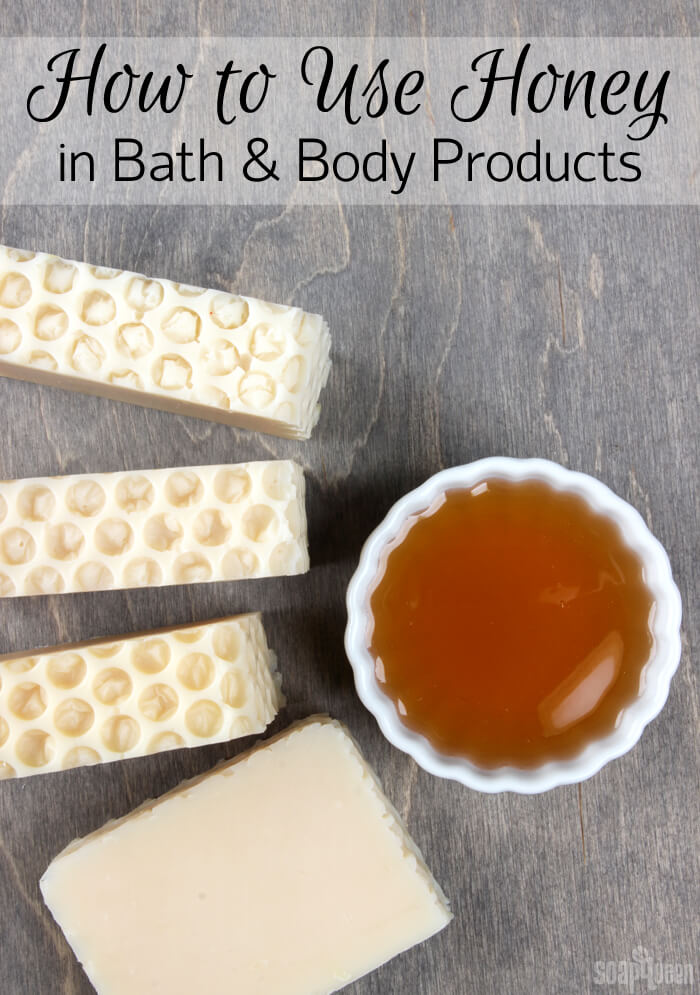
A humectant is an ingredient that absorbs moisture from the air. Natural humectants include aloe vera gel, eggs and honey. The humectant properties of honey, combined with its antioxidant properties, make it a popular choice for homemade bath and body projects. But, due to the natural sugars, water solubility and texture, it can be tricky to use properly. If you’d like to incorporate honey into your next project, the tips below will help.
Using Honey in Cold Process Soap
Honey in cold process soap gives additional humectant properties, helps create bubbles and is great from a marketing standpoint. It can be added to the soap at trace, or to the soaping oils prior to adding lye. Some soapmakers dilute the honey in a portion of the water in their recipe, and add the mixture at trace. How you add honey to cold process soap is a personal preference.
Keep in mind when you add honey to cold process recipes, you’re adding sugar. Cold process soap can become quite hot once the saponification process begins. Extra sugar in the soap batter will increase the temperature even more, which can cause the sugars to scorch. The scorched sugars produce a kind of caramelization in the soap, as well as a darker color. The extra heat also increases the likelihood of cracking, acceleration or a “soap volcano.”
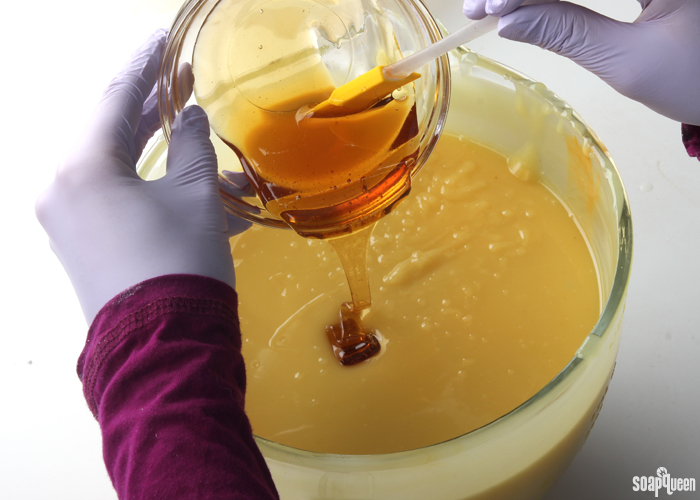
The key to adding honey to cold process soap is not using too much, and keeping temperatures cool. In general, I recommend about 1 teaspoon of honey per pound of total soap. You can add more. But, the more honey you add, the hotter your soap will become. I also recommend soaping on the cooler side, with lye and oils around 100° F. Then, place the soap in the fridge or freezer after pouring to keep it cool during the first few hours.
In the photo below, you can see what happens when honey becomes extremely hot in cold process soap. Both batches contained 2 teaspoons honey per pound of soap, which is more than recommended. Even when the soap was placed in the freezer, the soap got quite hot in the center! Click here to read more about using honey in cold process soap.
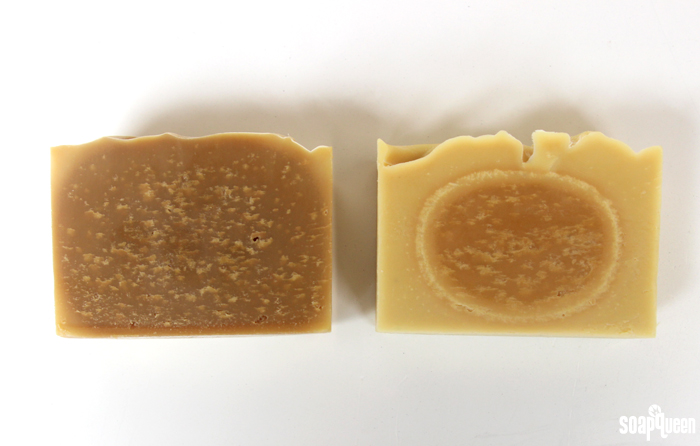 Using honey in cold process soap causes the soap to heat up and sometimes scorch, as shown above. Click here to learn more about using honey in cold process soap.
Using honey in cold process soap causes the soap to heat up and sometimes scorch, as shown above. Click here to learn more about using honey in cold process soap.
Using Honey in Melt & Pour Soap
It can be tempting to add oils and butters to melt and pour soap base. After all, it’s fun to make it your own formula! But, because melt and pour soap has already gone through the saponification process, additional oils and butters can cause the soap to not harden properly. Adding oils and butters can also increase sweating or inhibit lather. If you’d like to customize your base, I recommend no more than 1 teaspoon of extra oils or butters per pound of soap base.
I recommend 1/2 teaspoon per pound when adding honey to melt and pour soap base. Too much honey in melt and pour will cause the soap to become soft, increase glycerin dew, or the honey may separate from the base. The Honey Melt and Pour Soap Base is an easy way to incorporate honey into your melt and pour projects. Honey is the 5th ingredient in the base, which gives it a wonderful warm color.
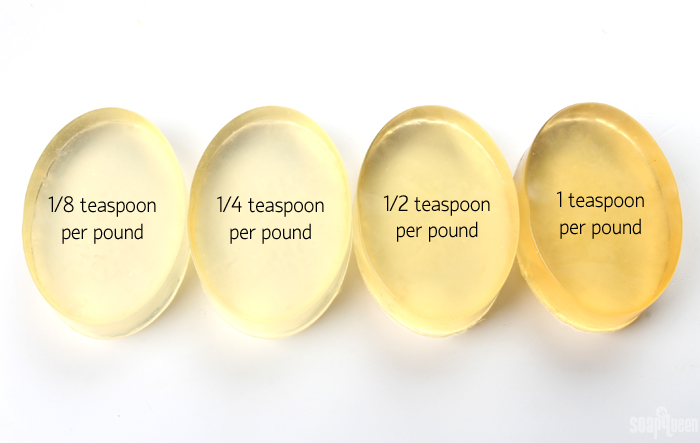 I tested adding honey to melt and pour at different usage rates. The soap with 1 teaspoon per pound of soap was quite dark, and slightly softer than the other bars.
I tested adding honey to melt and pour at different usage rates. The soap with 1 teaspoon per pound of soap was quite dark, and slightly softer than the other bars.
Out of curiosity, I tested adding honey into Clear Melt and Pour Base at different usage rates. I was curious to see how honey affects the color, lather and texture of the soap. In the photo above, the soaps (left to right) contain 1/8 teaspoon honey per pound of soap, 1/4 teaspoon per pound of soap, 1/2 teaspoon per pound of soap and 1 teaspoon per pound of soap. The more honey the darker the color of the soap. Once fully cooled, most of the bars were still firm. The only exception was the bar containing 1 teaspoon per pound – it was slightly softer. In the photo below, you can see the sides of the soap became slightly squished when firmly squeezed.
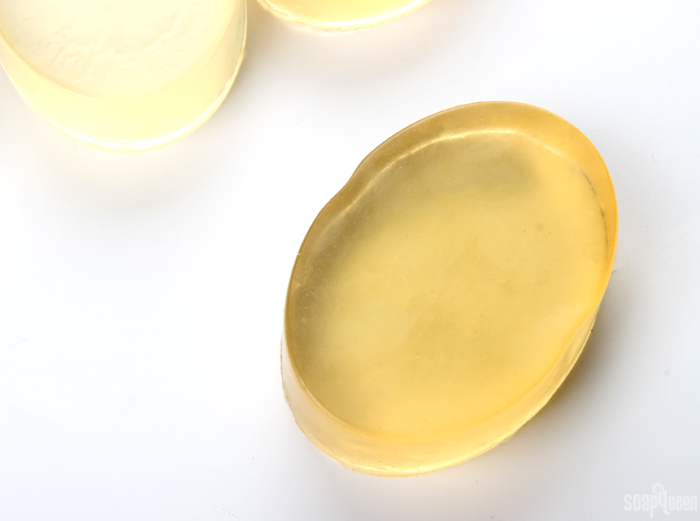 Adding extra honey to melt and pour soap base can cause the soap to become softer, as shown by the dent edges in the soap above.
Adding extra honey to melt and pour soap base can cause the soap to become softer, as shown by the dent edges in the soap above.
I tested the lather of the soaps containing 1/8 teaspoon honey per pound and the 1 teaspoon honey per pound. The soap with a full teaspoon of honey per pound of soap had a very dense, creamy lather. The soap containing 1/8 teaspoon honey per pound had a slightly fluffier lather. Both were lovely! The extra honey weighed down the bubbles, causing the creamier lather.
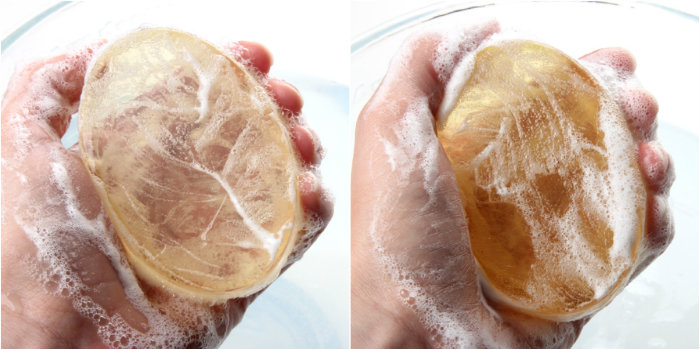 On the left, the soap with 1/8 teaspoon honey per pound of soap had a fluffy lather. The soap on the right with 1 teaspoon honey per pound had dense, creamy lather.
On the left, the soap with 1/8 teaspoon honey per pound of soap had a fluffy lather. The soap on the right with 1 teaspoon honey per pound had dense, creamy lather.
Using Honey in Lip & Body Balms
Honey is water soluble, which means it dissolves in water. Honey will not incorporate fully into recipes that are 100% oils and butters, like lip and body balms. Below, I added 1/2 teaspoon of honey to 4 ounces of the Nourish Lip Balm Base. Notice the little drops at the bottom? That’s the honey…not mixing in.
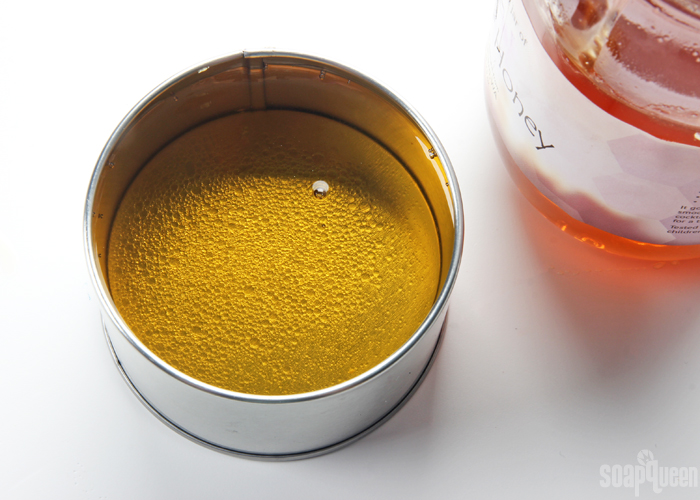 Honey does not mix into anhydrous products without an emulsifier. Above, you can see drops of honey at the bottom of the container.
Honey does not mix into anhydrous products without an emulsifier. Above, you can see drops of honey at the bottom of the container.
Even after plenty of mixing, honey does not mix into combinations of oils, waxes and butters. If you used honey in your balm, it may look great at first. But after a few weeks, the honey can start to separate from the balm. The balm can also take on a grainy appearance. Susan of Point of Interest (aka Swift Crafty Monkey) has a great article about using honey in products. This post also dives into the “science-y” aspects of why honey does not mix into oil-based products. The photo below is the same balm shown above. From the top, the balm looked perfectly fine! But, once I sliced into the balm and revealed the bottom, you can see all the honey sitting at the bottom of the container.
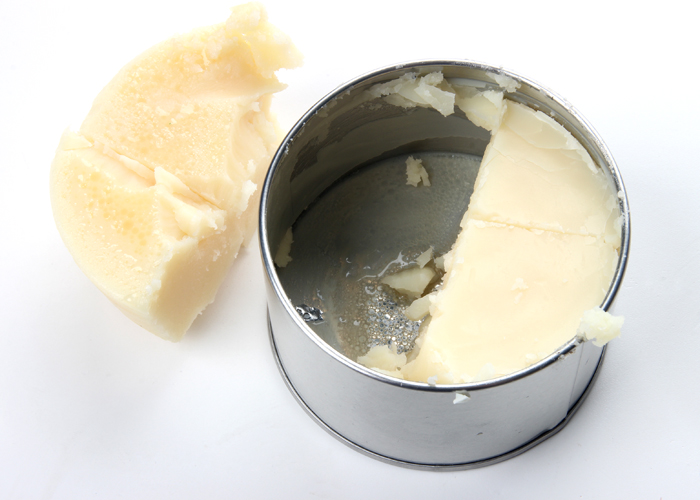 While the top of this balm looked great, the honey sank to the bottom of the balm.
While the top of this balm looked great, the honey sank to the bottom of the balm.
If you’d like to use honey in a balm or other anhydrous product, you need to use an emulsifier. The addition of honey to oil-based products also requires a preservative. Any product that contains water requires a preservative. Interestingly, honey contains a small amount of water. Use an oil soluble preservative like Optiphen or Phenonip when adding honey to anhydrous products. To learn more about preservatives, check out this post.
Using Honey in Emulsified Products (ie: lotion, emulsified scrubs)
Because honey is a water soluble product, it incorporates best in recipes that contain water, like lotion. Honey should be added to the water phase of any emulsified recipe and fully dissolved. A little honey in your emulsified products goes a long way, I would recommend 5% or less of your total recipe.
While honey does boast some antibacterial activity, it is not an effective preservative in products. If you are using honey in your lotion or emulsified product, it’s crucial to use a preservative to prevent mold and bacteria growth. We recommend a strong preservative when creating emulsified products containing honey, such as Germaben. If you’d like to learn more about preservatives, Susan from Point of Interest wrote an awesome guest post on the subject.
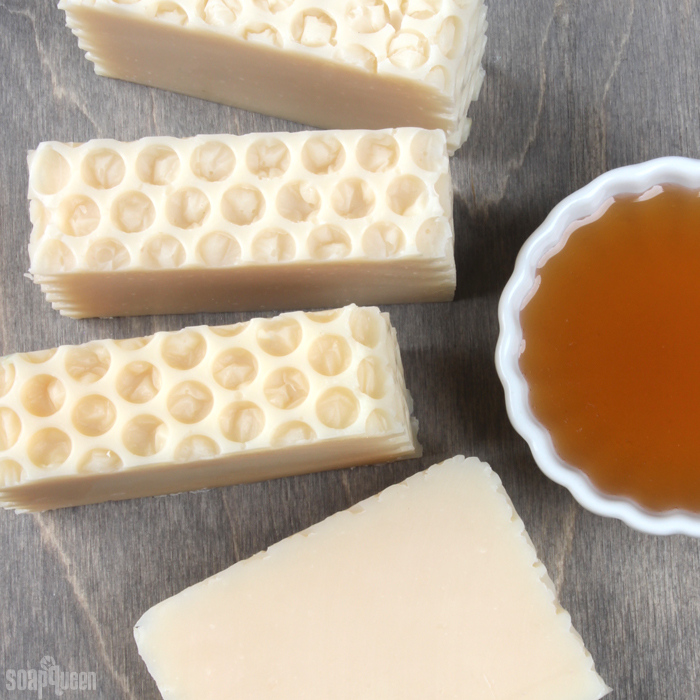
How do you like to use honey in your products? Do you have any observations to share? I’d love to hear them!




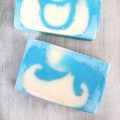
Hi
Is it better if i use Honey Powder instead as opposed to raw Honey in my handmade lotion?
I’d be expecting your reply!
Thanks
Some honey powder is water soluble, so I would contact the supplier of yours to find out. If it’s water soluble, it can be mixed into the water phase of your lotion. Some makers do prefer using the powder, but it’s a personal preference.
I want to use honey powder in my CP soaps, should I mix it with water or oil? Also, could I just add the powder to the oils prior to the lye?
Honey is water soluble, so you’ll want to add it to your cooled lye water or when the soap is first emulsified (thin trace). I would recommend thin trace, as the honey may react with the cooled lye water and scorch. Once the soap is poured into the mold, put it in the freezer for 5-24 hours to prevent overheating.
Sorry for the double post, but I forgot to add that my honey did not fall to the bottom of the container or separate from the rest of the ingredients.
I know this article is a bit old, but I wanted to add my experience using honey in my my homemade body butter. While just messing around with ingredients, I added a ton of honey to my tamanu butter recipe, which also included a number of oils like coconut, sweet almond and olive oil. I don’t have an exact recipe, because like I said, I was just messing around testing things. Long story short, it came out very sticky, but I use it anyway on my face because I have dry skin. But here it is nearly two months since I made that concoction and it’s just fine. No mold or mildew or bad smell… nothing.
That’s awesome, glad the recipe is working well for your skin.
Thank you for the information. Please will like to know if it is OK to add honey when making liquid body wash from bar soap. If yes at what stage should I do that?
We haven’t made liquid soap from bar soap, so I’m not entirely sure. What is in your recipe?
-Kelsey with Bramble Berry
How would a bit of honey react in a bath bomb mixture? I’m considering adding a little bit to my next batch.
We haven’t given that a try, so I’m not entirely sure. My only worry is that because honey is a humectant, it may draw moisture to the bath bomb and cause it to react. I would recommend making a small test bath bomb with honey to see what you think. If you don’t use it right away, make sure to wrap it tightly with plastic wrap and store it in a cool, dry place. Learn more about storing bath bombs here: http://www.soapqueen.com/bath-and-body-tutorials/tips-and-tricks/how-to-store-handmade-bath-products/
-Kelsey with Bramble Berry
Honey in lotion does not leave it sticky? Is it similar to adding glycerine to lotion? What are its effects on skin? I’m trying to design the ultimate luxury facial moisturiser. Honey sounds amazing in it. I’m collecting organic luxury oils and just bought rose hydrosol, and honey rose sounds heavenly!
Honey is a humectant like glycerin. That means it draws moisture to the skin and keeps it hydrated! Too much honey can make the lotion sticky. I would recommend starting with a small amount – about 1 teaspoon per pound. 🙂
-Kelsey with Bramble Berry
So ive successfully made an ointment with honey in it using a liquid emulsifier i bought from makingcosmetics. And made a nice lotion both for my babies. They work wonderfully for their soft delicate skin. I’ve been wanting to make a lipbalm for my oldest son and husband with honey in it to sooth their lips from working/playing outside every day. Would it work pretty much the same way as i made the ointment? Will polysorbate also work to emulsify it into the oils and waxes? Also, is there a a recommended amount of emulsifier(polysorbate) to incorporate it all together? Or should i stick with using the creammaker? I would like to try to use as little of that as possible as i only have a small bottle of it, yet have 2 bottles of polysorbate with another 1lbs bottle coming today in my Brambleberry order. So im thinking of ways to use Polysorbate more.lol
We don’t recommend Polysorbate 80 in lip balms because it isn’t a lip safe emulsifier. You’ll want to use one specifically formulated for lip balms. I’m not sure of where to find that, but someone on teachsoap.com/forum may know. 🙂
-Kelsey with Bramble Berry
Great information!!
Thanks Kinnery! 🙂
-Kelsey with Bramble Berry
Great article! I remember reading (or maybe it was a video??) about a soapmaker who added germaben to her honey CP soap. I didn’t think that was necessary for CP soap. Is there ever a time when you should add germaben to soap?
Thanks Judet, glad you like the post! Soap has a pH level that doesn’t allow mold to grow, so we don’t usually add preservatives to soap. 🙂
Read more about using preservatives here: http://www.soapqueen.com/bath-and-body-tutorials/lotion/talk-it-out-tuesday-preservatives/
-Kelsey with Bramble Berry
That’s why my lip balms sweats.. And I thought it’s melting .. It’s the HONEY then.. I took the recipe from 101 but I found that after a while say 2 weeks, when I push the the stick up it cracks and liquid comes out of it.. It’s the HONEY..Duh!
Thank you .. So helpful
You’re welcome Athari! Honey is definitely tricky to mix into lip balm, but we love it in soap. 🙂
-Kelsey with Bramble Berry
I read blogs from different soap makers online, they have the same problems like the volcano and the same as the picture shown above with different color in the middle, which is darker. It’s the same thing happens in fruit purees and fresh goats milk, which is really frustrating when I saw the bars of soaps have cracks and with different color in the middle. I tried another batch of 5-pound of Fresh Papaya Puree added with 5 tablespoons (1 tbsp/pound). To avoid the same problems that I had before, instead of pouring the traced mixture directly to the loaf mold, I covered the container with cling wrap and wait for 10 minutes to let it Gel. When gelling phase is reached, stir it and this time use the spoon technique when transferring it to the mold. It was successful, no more cracking and no more dark different color in the middle of my bars of soap. No refrigerations needed to fruit purees and or with honey CP soaps except with the Goats Milk. I haven’t tried this technique to swirling but to single color only. I hope this technique can help to soapers out there.
-Bec@Pearl Reflections
That’s a great tip Bec, thanks for sharing! We’ll definitely have to give that a try. 🙂
-Kelsey with Bramble Berry
Informative, as always! I’ve used honey with success in cp soap a few times for it’s darkening properties. I did not know that it is a humectant nor did I know that it adds to the lather. Thanks!
You’re welcome Eric, glad you enjoyed the post! 🙂
-Kelsey with Bramble Berry
I thought aloe would be considered in the water % of my lotions. Is that not true?
Aloe vera liquid is used as a water replacement in lotion! You can use 100% aloe liquid, or a mixture of aloe and distilled water. We used it in the Rose and Aloe In-Shower Lotion: https://www.soapqueen.com/bath-and-body-tutorials/lotion/rose-aloe-shower-lotion/
Aloe vera liquid: https://www.brambleberry.com/Aloe-Vera-Liquid-P3704.aspx
Learn more about formulating lotion in this post: https://www.soapqueen.com/bath-and-body-tutorials/lotion/how-to-create-homemade-lotion-recipes/
-Kelsey with Bramble Berry
I use Active Manuka Honey in my hand cream recipe (at 5%). It is wonderful for dry, chapped, irritated hands and definitely helps for those with ‘contact dermatitis’. The healing power of honey is amazing!
That sounds like an awesome recipe, very nice and moisturizing! 🙂
-Kelsey with Bramble Berry
Very interesting! Such great info.
Thanks Michael, glad you enjoyed the post!
-Kelsey with Bramble Berry